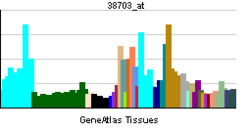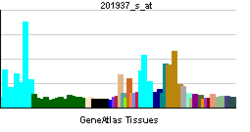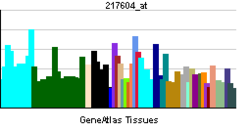- DNPEP
-
Aspartyl aminopeptidase Identifiers Symbols DNPEP; ASPEP; DAP External IDs OMIM: 611367 MGI: 1278328 HomoloGene: 6110 GeneCards: DNPEP Gene EC number 3.4.11.21 Gene Ontology Molecular function • aminopeptidase activity
• protein binding
• peptidase activity
• metallopeptidase activity
• zinc ion binding
• metal ion bindingCellular component • cytoplasm Biological process • proteolysis
• peptide metabolic processSources: Amigo / QuickGO RNA expression pattern 


More reference expression data Orthologs Species Human Mouse Entrez 23549 13437 Ensembl ENSG00000123992 ENSMUSG00000026209 UniProt Q9ULA0 Q3TVK3 RefSeq (mRNA) NM_012100 NM_016878 RefSeq (protein) NP_036232 NP_058574 Location (UCSC) Chr 2:
220.24 – 220.59 MbChr 1:
75.3 – 75.31 MbPubMed search [1] [2] Aspartyl aminopeptidase is an enzyme that in humans is encoded by the DNPEP gene.[1][2]
The protein encoded by this gene is an aminopeptidase which prefers acidic amino acids, and specifically favors aspartic acid over glutamic acid. It is thought to be a cytosolic protein involved in general metabolism of intracellular proteins.[2]
References
- ^ Wilk S, Wilk E, Magnusson RP (Aug 1998). "Purification, characterization, and cloning of a cytosolic aspartyl aminopeptidase". J Biol Chem 273 (26): 15961–70. doi:10.1074/jbc.273.26.15961. PMID 9632644.
- ^ a b "Entrez Gene: DNPEP aspartyl aminopeptidase". http://www.ncbi.nlm.nih.gov/sites/entrez?Db=gene&Cmd=ShowDetailView&TermToSearch=23549.
Further reading
- Ewing RM, Chu P, Elisma F, et al. (2007). "Large-scale mapping of human protein-protein interactions by mass spectrometry.". Mol. Syst. Biol. 3 (1): 89. doi:10.1038/msb4100134. PMC 1847948. PMID 17353931. http://www.pubmedcentral.nih.gov/articlerender.fcgi?tool=pmcentrez&artid=1847948.
- Rual JF, Venkatesan K, Hao T, et al. (2005). "Towards a proteome-scale map of the human protein-protein interaction network.". Nature 437 (7062): 1173–8. doi:10.1038/nature04209. PMID 16189514.
- Gerhard DS, Wagner L, Feingold EA, et al. (2004). "The status, quality, and expansion of the NIH full-length cDNA project: the Mammalian Gene Collection (MGC).". Genome Res. 14 (10B): 2121–7. doi:10.1101/gr.2596504. PMC 528928. PMID 15489334. http://www.pubmedcentral.nih.gov/articlerender.fcgi?tool=pmcentrez&artid=528928.
- Ota T, Suzuki Y, Nishikawa T, et al. (2004). "Complete sequencing and characterization of 21,243 full-length human cDNAs.". Nat. Genet. 36 (1): 40–5. doi:10.1038/ng1285. PMID 14702039.
- Prieto I, Hermoso F, Gasparo M, et al. (2004). "Angiotensinase activities in the kidney of renovascular hypertensive rats.". Peptides 24 (5): 755–60. doi:10.1016/S0196-9781(03)00121-9. PMID 12895663.
- Strausberg RL, Feingold EA, Grouse LH, et al. (2003). "Generation and initial analysis of more than 15,000 full-length human and mouse cDNA sequences.". Proc. Natl. Acad. Sci. U.S.A. 99 (26): 16899–903. doi:10.1073/pnas.242603899. PMC 139241. PMID 12477932. http://www.pubmedcentral.nih.gov/articlerender.fcgi?tool=pmcentrez&artid=139241.
- Wilk S, Wilk E, Magnusson RP (2002). "Identification of histidine residues important in the catalysis and structure of aspartyl aminopeptidase.". Arch. Biochem. Biophys. 407 (2): 176–83. doi:10.1016/S0003-9861(02)00494-0. PMID 12413488.
External Links
Hydrolase: proteases (EC 3.4) 3.4.11-19: Exopeptidase Dipeptidyl peptidase (Cathepsin C, Dipeptidyl peptidase-4) · Tripeptidyl peptidase (Tripeptidyl peptidase I, Tripeptidyl peptidase II)Other/ungrouped3.4.21-24: Endopeptidase Serine proteases · Cysteine protease · Aspartic acid protease · Metalloendopeptidases
Other/ungrouped: Amyloid precursor protein secretase (Alpha secretase, Beta-secretase 1, Beta-secretase 2, Gamma secretase)3.4.99: Unknown B enzm: 1.1/2/3/4/5/6/7/8/10/11/13/14/15-18, 2.1/2/3/4/5/6/7/8, 2.7.10, 2.7.11-12, 3.1/2/3/4/5/6/7, 3.1.3.48, 3.4.21/22/23/24, 4.1/2/3/4/5/6, 5.1/2/3/4/99, 6.1-3/4/5-6 Categories:- Human proteins
- Chromosome 2 gene stubs
- EC 3.4.11
Wikimedia Foundation. 2010.
